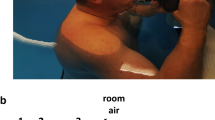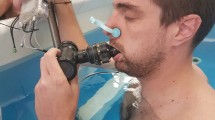Abstract
In diving, pulmonary mechanical function is limited by the increased density of the gas breathed. Breathing cold and dry gas may cause an additional increase in airways resistance. We have measured forced vital capacity, forced expired volume in 1 s (FEV1) and forced midexpiratory flow rate (FEF25%–75%) before and after breathing dry or humid gas at 29–32°C during a standardized exercise intensity on a cycle ergometer at an ambient pressure of 3.7 MPa. The atmosphere was a helium and oxygen mixture with a density of 6.8 kg · m−3. Six professional saturation divers aged 26–37 years participated in the study. There were no significant differences in convective respiratory heat loss between the exposures. The mean evaporative heat loss was 67 W (range 59–89) breathing dry gas and 37 W (range 32–43) breathing humid gas, corresponding to water losses of 1.7 g · min−1 (range 1.5–2.2) and 0.9 g · min−1 (range 0.8–1.1), respectively. There was a significant reduction in FEV1 of 4.6 (SD 3.6)% (P<0.05), and in FEF25%–75% of 5.8 (SD 4.7)% (P<0.05) after breathing dry gas. There were no changes after breathing humid gas. By warming and humidifying the gas breathed in deep saturation diving bronchoconstriction may be prevented.
Similar content being viewed by others
References
Bakke PS, Baste V, Gulsvik A (1991) Bronchial responsiveness in a Norwegian community. Am Rev Respir Dis 143:317–322
Blackie SP, Hilliam C, Village R, Pare PD (1990) The time course of bronchoconstrietion in asthmatics during and after isocapnic hyperventilation. Am Rev Respir Dis 142:1133–1136
Burnet H, Lucciano M, Jammes Y (1990) Respiratory effects of cold-gas breathing in humans under hyperbaric environment. Respir Physiol 81:413–424
Chapman KR, Allen LJ, Romer TT (1990) Pulmonary function in normal subjects following exercise at cold ambient temperatures. Eur J Appl Physiol 60:228–232
Deal EC, McFadden ER, Ingram RH, Breslin FJ, Jaeger JJ (1980) Airway responsiveness to cold air and hyperpnea in normal subjects and those with hay fever and asthma. Am Rev Respir Dis 121:621–628
Eschenbacher WL, Sheppard D (1985) Respiratory heat loss is not the sole stimulus for bronchoconstriction induced by isocapnic hyperpnea with dry air. Am Rev Respir Dis 131:894–901
Gulsvik A (1978) Obstructive lung disease in an urban population. Reprografisk Industri, Oslo, pp 80–122
Hahn A, Anderson AD, Morton AR, Black JL, Fifth KD (1984) A reinterpretation of the effect of temperature and water content of the inspired air in exercise-induced asthma. Am Rev Respir Dis 130:575–579
Jammes Y, Burnet H, Cosson P, Lucciano M (1988) Bronchomofor response to cold air or helium-oxygen at normal and high ambient pressure. Undersea Biomed Res 15:179–192
Maio DA, Farhi LE (1967) Effect of gas density on mechanics of breathing. J Appl Physiol 23:687–693
Moore TO, Morlock JF, Lally DA, Hong SK (1976) Thermal cost of saturation diving: respiratory and whole body heat loss at 16.1 ATA. In: Lambertsen CJ (ed) Underwater Physiology V, Proceedings of the Fifth Symposium on Underwater Physiology, Bethesda, Maryland. Undersea and Hyperbaric Medical Society, pp 741–754
O'Cain CF, Dowling NB, Slutsky AS, Hensley MJ, Strohl KP, McFadden ER, Ingram RH (1980) Airway effects of respiratory heat loss in normal subjects. J Appl Physiol 49:875–880
Piantadosi CA, Thalmann ED, Spaur WH (1981) Metabolic response to respiratory heat loss-induced core cooling. J Appl Physiol 50:829–834
Schoeffel RE, Anderson SD, Altounyan REC (1981) Bronchial hyper-reactivity in response to inhalation of ultrasonically nebulized solutions of distilled water and saline. BMJ 283:1285–1287
Seagrave RC (1971) Biomedical applications of heat and mass transfer. Iowa State University Press, Ames, Iowa, pp 12–13
Segadal K, Thorsen A, Myrseth E (1989) Methods for testing of breathing equipment. In: Lundgren CEG, Warkander DE (eds) Physiological and human engineering aspects of underwater breathing apparatus. Undersea and Hyperbaric Medical Society, Bethesda, pp 153–162
Thorsen E, Rønnestad I, Segadal K, Hope A (1992) Respiratory effects of warm and dry air at increased ambient pressure. Undersea Biomed Res 19:73–83
Tobin MJ, Guenther SM, Perez W, Mador MJ (1987) Accuracy of the respiratory inductance plethysmograph during loaded breathing. J Appl Physiol 62:497–505
Webb P (1982) Thermal problems. In: Bennett PB, Elliott DH (eds) The physiology and medicine of diving. Balliere Tindall, London, pp 297–318
Author information
Authors and Affiliations
Rights and permissions
About this article
Cite this article
Rønnestad, I., Thorsen, E., Segadal, K. et al. Bronchial response to breathing dry gas at 3.7 MPa ambient pressure. Europ. J. Appl. Physiol. 69, 32–35 (1994). https://doi.org/10.1007/BF00867924
Accepted:
Issue Date:
DOI: https://doi.org/10.1007/BF00867924




